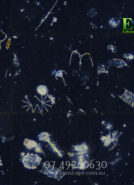CYANOBACTERIA TOXINS
Cyanobacteria, also commonly called blue-green algae, are present all around the world. Primarily in calm, nutrient-rich waters. A number of cyanobacteria species produce toxins, some of which, effect animals and humans. Some toxins may cause skin irritation on contact, and others can lead to serious health problems. Individuals may be exposed to cyanobacterial toxins by drinking or bathing in contaminated water, or by accidental ingestion during recreational water activities. The most common toxins occurring in Australia are Microcystins, Cylindrospermopsins, Saxitoxins and Lipopolysaccharides (LPS).
Microcystins
The most common cyanobacterial toxins found all around the world, in blooms from fresh and brackish waters are microcystins. Microcystins are a family of cyclic heptapeptide (7 amino acids), hepatotoxins (liver toxins) are produced by species of freshwater cyanobacteria. Microcystis toxins have been named after their primary producer Microcystis aeruginosa. Microcystins have been also characterised from planktonic Anabaena, Oscillatoria (Planktothrix), Nostoc, Anabaenopsis species and from terrestrial Hapalosiphongenera. There have been approximately 60 structurally similar microcystins identified to date. The toxin is chemically stable, but undergo biodegradation in reservoir waters. Its presence in a drinking water even at low concentrations is viewed as a risk factor to human wellbeing. Human contact with the microcystins often results in gastroenteritis and allergic/irritation reactions, however, the primary target of the toxin is the liver where its presence leads to substantial hepatic haemorrhages. Water solubility of most microcystins makes them unable to directly penetrate a lipid membrane of any cell. The toxin uses a carrier-mediated transport system to enter the liver cell. Microcystin binds strongly to the key cellular enzymes called protein phosphatases. Inhibition of this enzyme causes disruption of the cytoskeleton, which is followed up by a haemorrhage. A mouse bioassays showed that the cyanobacterial toxins resulted in the death of a mouse, due to a liver haemorrhage within a few hours of an acute dose.
Cylinrospermopsin
Cylindrospermopsin is a cyclic guanidine alkaloid classified as a cyanobacterial hepatoxin. It is a cyanotoxin well known for its high water solubility and resistance. Cylindrospermopsin is produced by Cylindrospermopsis raciborskii, Umezakia natans and Aphanizomenon ovalisporum, which are found in tropical and subtropical fresh waters. This powerful toxin poses health hazards to human, livestock and wildlife. Cylindrospermopsin has been shown to be cytotoxic, dermatotoxic, genotoxic, hepatotoxic and may be carcinogenic. Its toxicity is associated with inhibition of protein and glutathione synthesis. In addition, the toxin also stimulates genotoxicity and the alteration of different oxidative stress biomarkers. The mechanism of cylindrospermopsin adversely affects organs such as kidneys, spleen, intestine, thymus, liver and heart in an organism. Although liver appears to be the main target. The inhibition of the protein synthesis in this organ leads to membrane proliferation and fat droplet accumulation, ending in cell death.
Human may be exposed to cylindrospermopsin by drinking or swimming in contaminated water and by consuming foods in which the toxin may have bioaccumulated. Cylindrospermopsis raciborkii is regularly found in water supplies of Queensland.
Saxitoxins
Saxitoxins are a group of carbamate alkaloid neurotoxins widely known as one of the most toxic non-protein molecules. This potent biotoxin is produced by cyanobacteria such as Aphanizomenon flos-aquae, Anabaena circinalis, Lyngbya wollei and Cylindrospermopsis raciborskii. The direct consumption of this algae usually does not affect humans. Human intoxication often occurs by consumption of filter-feeding molluscs which by ingesting the algae bioaccumulate the toxin. Hence, saxitoxin is also known as paralytic shellfish poisoning (PSP). PSP leads to numbness of tongue, face and limbs, throat constriction and eventually it leads to complete respiratory paralysis. There have been numerous fatal cases of PSP reported around the world. A mice bioassays showed that dose of 0.2 milligram would prove fatal for the average weight human. The symptoms of PSP are a result of saxitoxin’s ability to block neuronal transmission by binding to the voltage-gated sodium channel which regulate the electrical charge used to transmit signals by allowing sodium ions to flow in and out of the cells. An inhibition of the nerve impulses transmission quickly leads to death via respiratory paralysis. Saxioxins, differently to other neurotoxins, can be found in both marine and freshwater environments.
Lipopolysaccharides
Lipopolysaccharides (LPS), known as irritant toxins, are compressed structures of sugar, often a hexose, and a lipid, usually a hydroxy C14-C18 fatty acid. They are an integral component of the outer membrane of the cell wall of all gram-negative bacteria, including cyanobacteria, where LPS bind with proteins and phospholipids to build structures.
Cosmopolitan Gram-negative cyanobacteria such as Microcystis aeruginosa may contaminate freshwater supplies by releasing LPS during aquatic blooms. LPS can significantly affect environmental and human health by binding to specific receptors in order to elicit the release of cytokines and other inflammatory mediators. LPS indirectly leads to pathological effects by initiating a cascade of host-mediated responses. Exposure to LPS can elicit irritant and allergenic responses, symptoms may include: fever, fatigue, headache, nausea, drowsiness, diarrhoea and skin rashes. Consequently, any exposed mammal tissue is a target organ for LPS. The chemical stability of cyanobacterial LPS in surface water and their toxicity mechanism is still largely unknown.




